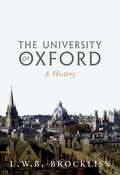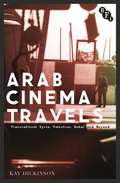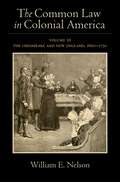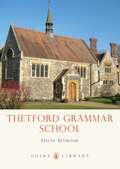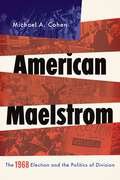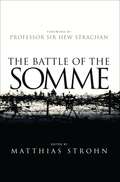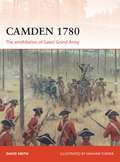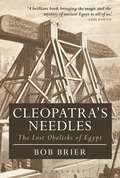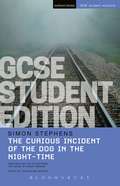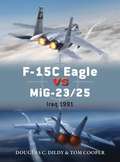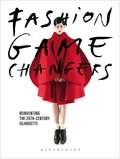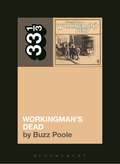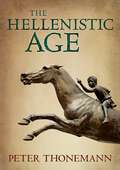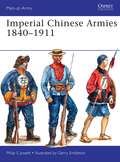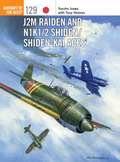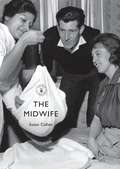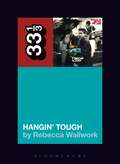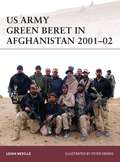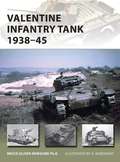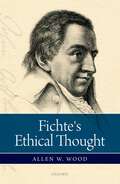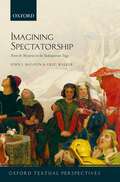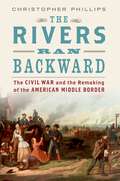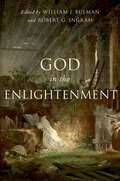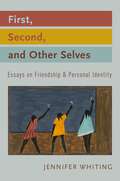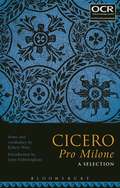- Table View
- List View
The University of Oxford: A History
by L.W.B. BrocklissThis fresh and readable account gives a complete history of the University of Oxford, from its beginnings in the eleventh century to the present day. Written by one of the leading authorities on the history of universities internationally, it traces Oxford's improbable rise from provincial backwater to one of the world's leading centres of research and teaching. Laurence Brockliss sees Oxford's history as one of discontinuity as much as continuity, describing it in four distinct parts. First he explores Oxford as 'The Catholic University' in the centuries before the Reformation, when it was principally a clerical studium serving the needs of the Western church. Then as 'The Anglican University', in the years from 1534 to 1845 when Oxford was confessionally closed to other religions, it trained the next generation of ministers of the Church of England, and acted as a finishing school for the sons of the gentry and the well-to-do. After 1845 'The Imperial University' saw the emergence over the following century of a new Oxford - a university which was still elitist but now non-confessional; became open to women as well as men; took students from all round the Empire; and was held together at least until 1914 by a novel concept of Christian service. The final part, 'The World University', takes the story forward from 1945 to the present day, and describes Oxford's development as a modern meritocratic and secular university with an ever-growing commitment to high-quality academic research. Throughout the book, Oxford's history is placed in the wider context of the history of higher education in the UK, Europe, and the world. This helps to show how singular Oxford's evolution has been: a story not of entitlement but of hard work, difficult decisions, and a creative use of limited resources and advantages to keep its destiny in its own hands.
Arab Cinema Travels: Transnational Syria, Palestine, Dubai and Beyond (Cultural Histories of Cinema)
by Kay DickinsonExploring the impact of travel on Arab cinema, Kay Dickinson reveals how the cinemas of Syria, Palestine and Dubai have been shaped by the history and politics of international circulation. This compelling book offers fresh insights into film, mobility and the Middle East.
The Common Law in Colonial America: Volume III: The Chesapeake and New England, 1660-1750
by William E. NelsonIn a projected four-volume series, The Common Law in Colonial America, William E. Nelson will show how the legal systems of Britain's thirteen North American colonies, which were initially established in response to divergent political, economic, and religious initiatives, slowly converged until it became possible by the 1770s to imagine that all thirteen participated in a common American legal order, which diverged in its details but differed far more substantially from English common law. Volume three, The Chesapeake and New England, 1660-1750, reveals how Virginia, which was founded to earn profit, and Massachusetts, which was founded for Puritan religious ends, had both adopted the common law by the mid-eighteenth century and begun to converge toward a common American legal model. The law in the other New England colonies, Nelson argues, although it was distinctive in some respects, gravitated toward the Massachusetts model, while Maryland's law gravitated toward that of Virginia.
Thetford Grammar School: Fourteen Centuries of Education
by David SeymourThetford Grammar School's formation is shrouded in mystery, but it may date back as far as 631. First re-founded by the Bishop of Norwich in 1114, the school was revitalised following the dissolution of the monasteries, and firmly re-established by an Act of Parliament in 1610 and then by a new foundation document in 1876. A Girls' School was set up alongside the ancient Boys' School in 1888 and both schools spent the middle years of the twentieth century as county council grammar schools, before their re-foundation as a co-educational independent school in 1981. Written to coincide with the 450th anniversary of Thetford Grammar School's re-founding and drawing on the school's archives, David Seymour discusses four and a half centuries of governance, pupils, headteachers, ushers and assistant teachers, phases of building, and the development of the curriculum.
American Maelstrom: The 1968 Election and the Politics of Division (Pivotal Moments in World History)
by Michael A. CohenIn his presidential inaugural address of January 1965, Lyndon B. Johnson offered an uplifting vision for America, one that would end poverty and racial injustice. Elected in a landslide over the conservative Republican Barry Goldwater and bolstered by the so-called liberal consensus, economic prosperity, and a strong wave of nostalgia for his martyred predecessor, John F. Kennedy, Johnson announced the most ambitious government agenda in decades. Three years later, everything had changed. Johnson's approval ratings had plummeted; the liberal consensus was shattered; the war in Vietnam splintered the nation; and the politics of civil rights had created a fierce white backlash. A report from the National Committee for an Effective Congress warned of a "national nervous breakdown." The election of 1968 was immediately caught up in a swirl of powerful forces, and the nine men who sought the nation's highest office that year attempted to ride them to victory-or merely survive them. On the Democratic side, Eugene McCarthy energized the anti-war movement; George Wallace spoke to the working-class white backlash; Robert Kennedy took on the mantle of his slain brother. Entangled in Vietnam, Johnson, stunningly, opted not to run again, scrambling the odds. On the Republican side, 1968 saw the vindication of Richard Nixon, who outhustled Nelson Rockefeller, Ronald Reagan, and George Romney by navigating between the conservative and moderate wings of the Republican Party. The assassinations of the first Martin Luther King, Jr., and then Kennedy, seemed to push the country to the brink of chaos, a chaos reflected in the Democratic Convention in Chicago, a televised horror show. Vice President Hubert Humphrey emerged as the nominee, and, finally liberating himself from Johnson's grip, nearly overcame the lead long enjoyed by Nixon, who, by exploiting division and channeling the national yearning for order, would be the last man standing. In American Maelstrom, Michael A. Cohen captures the full drama of this watershed election, establishing 1968 as the hinge between the decline of political liberalism, the ascendancy of conservative populism, and the rise of anti-governmental attitudes that continue to dominate the nation's political discourse. In this sweeping and immersive book, equal parts compelling analysis and thrilling narrative, Cohen takes us to the very source of our modern politics of division.
The Battle of the Somme
by Hew Strachan Jonathan Krause Matthias StrohnPublished to coincide with the centenary commemoration of the battle of the Somme, this new study comprises 12 separate articles written by some of the foremost military historians, each of whom looks at a specific aspect of the battle. Focusing on key aspects of the British, French and German forces, overall strategic and tactical impacts of the battle and with an introduction by renowned World War I scholar Professor Sir Hew Strachan, The Battle of the Somme is a timely collection of the latest research and analysis of the battle.The terrors of the Somme have largely come to embody trench warfare on the Western Front in the modern imagination, but this new book looks beyond the horrendous conditions and staggering casualty rates to provide new, insightful research on one of the most pivotal battles of the war.
Camden 1780: The annihilation of Gates’ Grand Army (Campaign #292)
by Graham Turner David SmithAs the American Revolution continued, the British refocused their fight on the southern colonies in the hopes of triggering an outbreak of loyalism that would sweep the rebels aside. Under Sir Henry Clinton they captured Savannah at the end of 1778, and Charleston in May 1780, with Lord Cornwallis being left in command with just 8,500 men under him. Too thinly spread to guard the 15,000 square miles he was responsible for, Cornwallis went on the offensive, invading North Carolina and using Camden as a launch pad. This new history reveals how Cornwallis was able to use his aggressive strategy to great effect and how the overconfidence of the re-formed American forces under Horatio Gates was to result in a shocking defeat on the night of 15 August 1780 – a defeat that would allow Cornwallis to push deep into North Carolina the following year, where he would only be stopped by the American victory at Yorktown.
Cleopatra's Needles: The Lost Obelisks of Egypt (Bloomsbury Egyptology)
by Bob BrierIn the half-century between 1831 and 1881 three massive obelisks left Egypt for new lands. Prior to these journeys, the last large obelisk moved was the Vatican obelisk in 1586 – one of the great engineering achievements of the Renaissance. Roman emperors moved more than a dozen, but left no records of how they did it. The nineteenth-century engineers entrusted with transporting the obelisks across oceans had to invent new methods, and they were far from certain that they would work. As the three obelisks, bound for Paris, London and New York, sailed towards their new homes, the world held its breath. Newspapers reported the obelisks' daily progress, complete with dramatic illustrations of the heroic deeds of the engineers and crews struggling under nearly impossible conditions. When the obelisks finally arrived safely in their new homes, bands played Cleopatra's Needle Waltz and silver obelisk pencils dangled from fashionable ladies' necks. This turbulent era, caught up in obelisk mania, is recreated by Bob Brier in all its glory. Amid astounding tales of engineering dexterity and naval endurance, the individuals involved in transporting the obelisks and receiving them in their future homes are brought to life through their letters and diaries, newspaper articles and illustrations. Written by a renowned Egyptologist and author, this compelling book will fascinate all those interested in Egypt, its iconic monuments and the history of great endeavour.
The Curious Incident of the Dog in the Night-Time GCSE Student Edition (GCSE Student Guides)
by Simon Stephens Jacqueline BoltonWritten specifically for GCSE students by academics in the field, the Methuen Drama GCSE Student Editions provide in-depth explanatory material alongside the play texts frequently studied at Key Stage 4. Whether for use in the classroom or independent study, these editions offer a fully comprehensive and lightly glossed play text with accompanying notes specifically directed towards readers of this age, which unravel essential topics and challenge all students to delve further into literary analysis. In Simon Stephens's multi-award-winning stage adaptation of The Curious Incident of the Dog in the Night-Time, based on Mark Haddon's novel, Christopher's investigation into the death of the neighbour's dog tears his world apart and confronts him with the struggle to survive when everything feels foreign.In addition to some on-page explanatory notes and the play text itself, this edition contains sub-headed analyses of themes, characters, context and dramatic devices, as well as background information on the playwright. The Methuen Drama GCSE Student Editions never lose sight of their readership, and offer students the confidence to engage with the material, explore their own interpretations, and improve their understanding of the works.
F-15C Eagle vs MiG-23/25: Iraq 1991 (Duel)
by Jim Laurier Doug Dildy Tom CooperDesigned following the relatively poor performance of America's multi-role fighters during the Vietnam War, the F-15 Eagle was conceived as a dedicated air superiority fighter. But, having trained for 15 years in the Eagle it wasn't Eastern Bloc operated MiGs that the F-15 eventually came up against, but pilots of Saddam Hussein's Iraqi airforce.This book analyses the combat between the American and Soviet 'Cold War fighters' in a balanced manner, examining how the technical abilities of the aircraft combined with the different levels of training available to opposing pilots and groundcrews allowed the F-15s to destroy the Iraqi offensive abilities within weeks of the First Gulf War starting. Packed with artwork, illustrations and photographs, this book places the reader in the cockpit during one of the last major dogfighting air wars in modern history.
Fashion Game Changers: Reinventing the 20th-Century Silhouette
by Karen Van Godtsenhoven Miren Arzalluz Kaat DeboFashion Game Changers traces radical innovations in Western fashion design from the beginning of the 20th century to the present.Challenging the traditional silhouettes of their day, fashion designers such as Madeleine Vionnet and Cristóbal Balenciaga began to liberate the female body from the close-fitting hourglass forms which dominated European and American fashion, instead enveloping bodies in more autonomous garments which often took inspiration from beyond the West. As the century progressed, new generations of avant-garde designers from Rei Kawakubo to Martin Margiela further developed the ideas instigated by their predecessors to defy established notions of femininity in dress, creating space between body and garment. This way, a new relationship between body and dress emerged for the 21st century.With over 200 images and commentaries from an international range of leading fashion curators and historians, this beautifully illustrated book showcases some of the most revolutionary silhouettes and innovative designs of over 100 years of fashion.
Grateful Dead's Workingman's Dead (33 1/3)
by Buzz PooleReleased in 1970, Workingman's Dead was the breakthrough album for the Grateful Dead, a cold-water-shock departure from the Acid Test madness of the late '60s. It was the band's most commercially and critically successful release to date. More importantly, these songs established the blueprint for how the Dead would maintain and build upon a community held together by the core motivation of rejecting the status quo – the "straight life†? – in order to live and work on their own terms. As a unified whole, the album's eight songs serve as points of entry into a fully-rendered portrait of the Grateful Dead within the context of late twentieth-century American history. These songs speak to the attendant cultural and political anxieties that resulted from the idealism of the '60s giving way to the uncomfortable realities of the '70s, and the band's evolving perspective on these changes. Based on research, interviews, and personal experience, this book probes the paradox at the heart of the band's appeal: the Grateful Dead were about much more than music, though they were really just about the music.
The Hellenistic Age
by Peter ThonemannThe three centuries which followed the conquests of Alexander are perhaps the most thrilling of all periods of ancient history. This was an age of cultural globalization: in the third century BC, a single language carried you from the Rhône to the Indus. A Celt from the lower Danube could serve in the mercenary army of a Macedonian king ruling in Egypt, and a Greek philosopher from Cyprus could compare the religions of the Brahmins and the Jews on the basis of first-hand knowledge of both. Kings from Sicily to Tajikistan struggled to meet the challenges of ruling multi-ethnic states, and Greek city-states came together under the earliest federal governments known to history. The scientists of Ptolemaic Alexandria measured the circumference of the earth, while pioneering Greek argonauts explored the Indian Ocean and the Atlantic coast of Africa. Drawing on inscriptions, papyri, coinage, poetry, art, and archaeology Peter Thonemann opens up the history and culture of the vast Hellenistic world, from the death of Alexander the Great (323 BC) to the Roman conquest of the Ptolemaic kingdom (30 BC).
Imperial Chinese Armies 1840–1911 (Men-at-Arms)
by Gerry Embleton Philip JowettAn in-depth analysis of the Chinese Armies that fought a series of increasingly fractious wars over nearly a century. Beginning with a run through of the Chinese forces that combated the British and French during the two Opium Wars, this history goes on to trace the forces who were drawn into internal wars and rebellions in the 1850s and 60s, the open warfare in North Vietnam, the string of defeats suffered during the First Sino-Japanese war and the Boxer Rebellion. Providing an unparalleled insight into the dizzying array of troop types and unique uniforms, this is a history of the sometimes-painful modernization of China's military forces during one of her most turbulent periods of history.
J2M Raiden and N1K1/2 Shiden/Shiden-Kai Aces (Aircraft of the Aces)
by Jim Laurier Tony Holmes Mark Postlethwaite Yasuho IzawaAlthough seen as a replacement for the A6M Zero-sen carrier-based fighter, the Mitsubishi J2M Raiden was actually designed as a land-based naval interceptor optimised for speed rather than manoeuvrability. Engine cooling problems for its Mitsubishi Kasai 23 engine, airflow and flight control issues plagued the Raiden's development, but despite these production delays, aces Sadaaki Akamatsu Yoshihiro Aoki, Susumu Ito and Susumu Ishihara all claimed significant scores in the Raiden. Kawanishi's N1K family of fighters were privately developed by the manufacturer from the N1K Kyofu floatplane fighter. Again plagued by structural and engine maladies, the N1K1-J Shiden eventually entered frontline service in time to see considerable action in the doomed defence of the Philippines in October 1944. Despite suffering heavy losses, the units equipped with new fighter proved that the N1K could more than hold its own against P-38s and F6Fs. The improved N1K2-J Shiden-KAI started to reach the frontline by late 1944 – in time for defence of the Home Islands. Here, it proved to be the best IJN fighter of the war.
The Midwife (Shire Library)
by Susan CohenThe midwife: medical professional, friend in a woman's hour of greatest need, potent social and cultural symbol. Though the role of midwife has existed since time immemorial, it is only since the Victorian era that it has been a recognised and regulated profession. This book, from social history expert Susan Cohen, looks at midwifery in Britain from ancient times up to the present, paying particular attention to its incredible medical and social advances of the last 150 years. It is a fully illustrated tour that takes in fictional midwives such as Dickens' Sarey Gamp, the founding of the Royal College of Midwives in 1881, the Second World War, the forming of the NHS and the Central Midwives Board, and looks at the increasing medicalisation of childbirth and the countervailing trend for giving birth at home.
New Kids on the Block's Hangin' Tough (33 1/3)
by Rebecca WallworkHangin' Tough, the second album by the New Kids on the Block, has sold more than seventeen million copies worldwide since it was released in 1988. But the album and the band have also been dismissed, derided and deemed uncool by the music establishment. Almost thirty years later, the New Kids still perform the songs from Hangin' Tough.Hundreds of thousands of grown women still flock to their concerts to hear-and go bat-shit crazy for-the songs they first heard when they were teenagers. Is this mere nostalgia or can the science of music help explain the enduring success of Hangin' Tough? What is it about this album that made it so special? Is the music any good or are there other factors at play too?Journalist and New Kids fan Rebecca Wallwork sets out to analyze the quality of Hangin' Tough with the help of music cognition experts, critics, producers and music industry pros. This is not a story about crazy fans, boy bands and truckloads of cheesy merchandise; it is an exploration of a watershed album and moment in pop culture history. It is a glimpse into the brain of not just New Kids fans, but into the minds and hearts of anyone who loves music.
US Army Green Beret in Afghanistan 2001–02 (Warrior)
by Peter Dennis Leigh NevilleIn October 2001 the most militarily advanced nation on earth came into conflict with one of the least developed nations as American forces poured into Afghanistan. The tip of the spear was drawn from the US Special Forces community, and largely from the units of the United States Army Special Forces – the famous Green Berets. Together with the Special Activities Division of the CIA and the Afghan Northern Alliance, they overthrew the Taliban in a lightning campaign that redefined modern warfare.This new study reveals the grueling Green Beret training and preparation, the specialized equipment they used in the field and traces their deployment throughout the campaign, from the first insertion of forces through to the fall of Kabul and Kandahar, the Taliban uprising at the notorious Fort of War in Mazar-e-Sharif, and the clearance of Tora Bora and Operation Anaconda in the Shahikot Valley.
Valentine Infantry Tank 1938–45 (New Vanguard #233)
by Bruce Newsome Henry MorsheadThe Valentine was the most produced and most widely used British tank of the Second World War. The Valentine first saw combat during Operation Compass in November 1941 and remained one of the main medium tanks in British service into 1943. As the Churchill became more prevalent the Valentine was relegated to specialist and tank-destroyer variants, which would remain in service in the Far East to the end of the war.This book describes the evolution of the Valentine design and weighs up its impact on the battlefield. Although widely regarded today as one of the weaker tanks to be fielded during the war, it was exceptionally numerous, with more Valentines produced than any other British tank.
Fichte's Ethical Thought
by Allen W. WoodAllen W. Wood presents the first book-length systematic exposition in English of Fichte's most important ethical work, the System of Ethics (1798). He places this work in the context of Fichte's life and career, of his philosophical system as conceived in the later Jena period, and in relation to his philosophy of right or justice and politics. Wood discusses Fichte's defense of freedom of the will, his grounding of the moral principle, theory of moral conscience, transcendental deduction of intersubjectivity, and his conception of free rational communication and the rational society. He develops and emphasizes the social and political radicalism of Fichte's moral and political philosophy, and brings out the philosophical interest of Fichte's positions and arguments for present day philosophy. Fichte's Ethical Thought defends the position that Fichte is a major thinker in the history of ethics, and the most important figure in the history of modern continental philosophy in the past two centuries.
Imagining Spectatorship: From the Mysteries to the Shakespearean Stage (Oxford Textual Perspectives)
by John J. McGavin Greg WalkerOxford Textual Perspectives is a new series of informative and provocative studies focused upon literary texts (conceived of in the broadest sense of that term) and the technologies, cultures and communities that produce, inform, and receive them. It provides fresh interpretations of fundamental works and of the vital and challenging issues emerging in English literary studies. By engaging with the materiality of the literary text, its production, and reception history, and frequently testing and exploring the boundaries of the notion of text itself, the volumes in the series question familiar frameworks and provide innovative interpretations of both canonical and less well-known works. Imagining Spectatorship offers a new discussion of how spectators witnessed early drama in the various spaces and places in which those works were performed. It combines broad historical and theoretical reflection with closely analysed case studies to produce a comprehensive account of the ways in which individuals encountered early drama, how they were cued to respond to it, and how we might think about those issues today. It addresses the practical matters that conditioned spectatorship, principally those concerned with the location and configuration of the spaces in which a performance occurred, but also suggests how these factors intersected with social status, gender, religious commitment and affiliation, degrees of real or felt personal agency, and the operation of the cognitive processes themselves. It considers both real witnesses and those 'imagined' spectators which are seemingly figured by both dramatic and quasi-dramatic works, and whose assumed attitudes play-makers sought to second-guess. It also looks at the spectatorial experience itself as a subject of representation in a number of early texts. Finally, it examines the complex contract entered into by audiences and players for the duration of a performance, looking at how texts cued spectators to respond to specific dramaturgical tropes and gambits and how audience response was itself a cause of potential anxiety for writers. The book resists the conventional divide between 'medieval' and 'early-modern' drama, using its focus on the spectators' experience to point connections and continuities across a diverse range of genres, such as processions and tourneys as well as scripted plays, pageants, and interludes; a variety of different venues, such as city streets, great halls, and playhouses, and a period of about 150 years to the Shakespearean stage of the 1590s and 1600s. It seeks to offer routes by which inferences about early spectatorship can be made despite the relative absence of personal testimony from the period.
The Rivers Ran Backward: The Civil War and the Remaking of the American Middle Border
by Christopher PhillipsMost Americans imagine the Civil War in terms of clear and defined boundaries of freedom and slavery: a straightforward division between the slave states of Kentucky and Missouri and the free states of Illinois, Indiana, Ohio, and Kansas. However, residents of these western border states, Abraham Lincoln's home region, had far more ambiguous identities-and contested political loyalties-than we commonly assume. In The Rivers Ran Backward, Christopher Phillips sheds light on the fluid political cultures of the "Middle Border" states during the Civil War era. Far from forming a fixed and static boundary between the North and South, the border states experienced fierce internal conflicts over their political and social loyalties. White supremacy and widespread support for the existence of slavery pervaded the "free" states of Ohio, Indiana, and Illinois, which had much closer economic and cultural ties to the South, while those in Kentucky and Missouri held little identification with the South except over slavery. Debates raged at every level, from the individual to the state, in parlors, churches, schools, and public meeting places, among families, neighbors, and friends. Ultimately, the pervasive violence of the Civil War and the cultural politics that raged in its aftermath proved to be the strongest determining factor in shaping these states' regional identities, leaving an indelible imprint on the way in which Americans think of themselves and others in the nation. The Rivers Ran Backward reveals the complex history of the western border states as they struggled with questions of nationalism, racial politics, secession, neutrality, loyalty, and even place-as the Civil War tore the nation, and themselves, apart. In this major work, Phillips shows that the Civil War was more than a conflict pitting the North against the South, but one within the West that permanently reshaped American regions.
God in the Enlightenment
We have long been taught that the Enlightenment was an attempt to free the world from the clutches of Christian civilization and make it safe for philosophy. The lesson has been well learned. In today's culture wars, both liberals and their conservative enemies, inside and outside the academy, rest their claims about the present on the notion that the Enlightenment was a secularist movement of philosophically driven emancipation. Historians have had doubts about the accuracy of this portrait for some time, but they have never managed to furnish a viable alternative to it-for themselves, for scholars interested in matters of church and state, or for the public at large. In this book, William J. Bulman and Robert G. Ingram bring together recent scholarship from distinguished experts in history, theology, and literature to make clear that God not only survived the Enlightenment but thrived within it as well. The Enlightenment was not a radical break from the past in which Europeans jettisoned their intellectual and institutional inheritance. It was, to be sure, a moment of great change, but one in which the characteristic convictions and traditions of the Renaissance and Reformation were perpetuated to the point of transformation, in the wake of the Wars of Religion and during the early phases of globalization. The Enlightenment's primary imperatives were not freedom and irreligion but peace and prosperity. As a result, Enlightenment could be Christian, communitarian, or authoritarian as easily as it could be atheistic, individualistic, or libertarian. Honing in on the intellectual crisis of the late seventeenth and early eighteenth centuries while moving from Spinoza to Kant and from India to Peru, God in the Enlightenment takes a prism to the age of lights.
First, Second, and Other Selves: Essays on Friendship and Personal Identity
by Jennifer WhitingIn her essay collection First, Second, and Other Selves: Essays on Friendship and Personal Identity, well-known scholar of ancient philosophy Jennifer Whiting gathers her previously published essays taking Aristotle's theories on friendship as a springboard to engage with contemporary philosophical work on personal identity and moral psychology. Whiting examines three themes throughout the collection, the first being psychic contingency, or the belief that the psychological structures characteristic of human beings may in fact vary, not just from one cultural (or socio-historical) context to another, but also from one individual to another. The second theme is the belief that friendship informs an understanding of the nature of the self, an idea that springs from Whiting's uncommon reading of Aristotle's writings on friendship. Specifically, Whiting explains a scenario in which a "virtuous agent" adopts a kind of impersonal attitude both towards herself and towards her "character" friends, loving both because they are virtuous; this scenario ties in with an examination of the Aristotelian concept of the ideal friend as an "other self," or a friendship that evolves from character rather than ego, as well as Whiting's meditation on whether or not a virtuous individual should have a "special" sort of concern for her own future self, distinct in kind from the concern that she has for others. The third theme is that of rational egoism, a concept that Whiting critiques, especially in the context of Aristotle's eudaimonism. The central tenet of the collection is the message that taking "ethocentric" (or character-based) attitudes both towards ourselves and towards our friends sheds light on the nature of personal identity and helps to combat ethnocentric and other objectionable forms of bias, a message that is becoming increasingly urgent in light of the recent deaths of Trayvon Martin and Michael Brown.
Cicero Pro Milone: A Selection
by Robert West Lynn FotheringhamThis is the OCR-endorsed publication from Bloomsbury for the Latin AS and A-Level (Group 1) prescription of Cicero's pro Milone sections 24–32, 34–35 and 43–52, and the A-Level (Group 2) prescription of sections 53–64 (to defendere) and 72–80, giving full Latin text, commentary and vocabulary, with a detailed introduction that also covers the prescribed text to be read in English for A Level.The death of Publius Clodius and the prosecution of Milo for his murder came at a critical point in the history of the late Republic, with Civil War and the collapse of the Republic only three years away. In his passionate defence of Milo, Cicero pleads for the rule of law as a vital counterweight to the anarchy that the gangs of Clodius, and Milo, had created. The published speech was regarded as a masterpiece of oratory in its own time, and is still held to be one of his finest compositions and a model for the presentation of such a defence.
